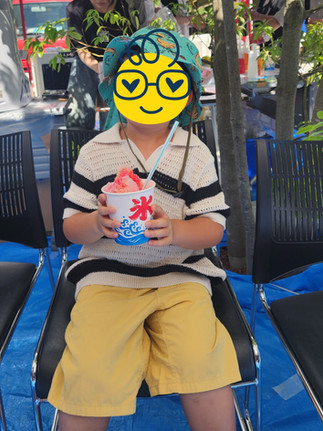Travel to Japan with kids: A Memorable Week in Setagaya, Tokyo with My 4yo Boy
- Edoory Kids Japan

- Oct 9
- 5 min read
— A journey that blends travel and education —
1 Kindergarten stay... in Japan?
Have you ever wondered what it would be like for your child to actually attend a kindergarten in Japan?
As a parent raising a child overseas, it’s something I had often been curious about. At first, I honestly thought, “Is it even possible to join a Japanese kindergarten for just a short time?”
But this year, my 4-year-old son had the chance to spend one week at a kindergarten in Setagaya, Tokyo—and it turned out to be an unforgettable experience for our whole family, combining both travel and education in the most heartwarming way.
In this post, I’ll share our experience—what my son’s days were like, what surprised us, and what I learned as a parent. I hope it helps other families who might be thinking about giving their child a similar experience in Japan.

2 Life in Setagaya
Our stay took place in Setagaya, one of Tokyo’s most family-friendly areas.
It’s a neighborhood full of parks and greenery, with a calm atmosphere that makes you forget you’re in a huge city. The area feels safe, with cozy shopping streets, supermarkets, and plenty of little bakeries—perfect for everyday life.
Even just walking around with my son was enjoyable. We discovered a small local coffee shop that quickly became our favorite spot.
Beyond sightseeing, we got a real glimpse into what everyday family life in Tokyo looks like—and that made this trip all the more meaningful.
3 The Little Japanese Kindergarten That Welcomed Us
The kindergarten we joined was a long-established public school quietly nestled in a residential area. The moment I saw it, I felt the warmth of a place deeply rooted in its community.
The building itself wasn’t new, but it was spotless and lovingly maintained. The wooden floors shone from years of care, and every corner reflected Japan’s beautiful “take good care of things” culture.
There was even a small pool in the yard for the children to enjoy in summer—something my son looked forward to every night: “Do we get to swim tomorrow?”
During our stay, the children’s aizome (indigo-dye) art was displayed around the school. It looked like a small museum, filled with creativity. My son stood in front of the artwork, eyes sparkling. It was clear that imagination was truly valued here.
The school even lent us a full set of the kindergarten uniform, complete with hat and bag. My son proudly posed in front of the mirror—instantly looking like a real kindergartener.

4 The First-Day Nerves—and a Lovely Surprise
Of course, the first day came with some nerves. New place, new friends—I was anxious too.
But those worries disappeared quickly. The teachers were kind and attentive, speaking gently to each child. Within minutes, my son relaxed and joined the class.
The class had about 15 children—just the right size. Soon he was playing tag and building blocks with new friends. When we got home, he proudly told me, “I played with ___ today!” remembering his friend’s name with a big smile.
Peeking into the classroom at pick-up time, I saw him chatting happily with a classmate—and my heart melted.
He especially loved arts and crafts. The teachers created an environment where children could follow their curiosity while learning basic routines. Surrounded by paper, boxes, and colorful materials, he spent hours creating and imagining. Every day, he came home with new “masterpieces” and stories about what he made and who helped him.

5 Small Challenges, Big Growth
At the kindergarten, play and learning naturally blended together. Each day offered small challenges and discoveries that helped my son grow.
Take the uniform buttons, for example. At first, he struggled with them, but after a few days of trying, he could fasten them all by himself. A small thing—but for him, it was a huge moment of confidence.
In the schoolyard stood a single tall pine tree. It became his favorite friend. He collected pinecones every day, washed them carefully, and lined them up back home. By the end of the week, he had a bucket full of them—his own little treasures.
One morning, the children harvested cherry tomatoes from the school garden. My son came home proudly holding his share, saying, “I picked them!” That evening, he couldn’t stop saying, “So yummy!” after every bite.
Through simple activities like these, he learned the joy of growing, harvesting, and appreciating food.

6 Discovering Japanese Culture
What stood out to me most was the greeting routine at the kindergarten.
Each morning and afternoon, every child would walk up to the teacher, look them in the eye, and say a cheerful “Ohayou gozaimasu!” (“Good morning!”) or “Sayonara!” (“Goodbye!”).
Watching my son copy the others—first shyly, then with increasing confidence—was heartwarming.
Even in just a few days, he learned how meaningful it is to greet someone properly and connect with them through a simple, genuine exchange.
It made me realize how these small, everyday practices reflect an important part of Japan’s educational culture—teaching children to value respect and human connection from an early age.
Outside the school, we also got to experience Japanese traditions.
One afternoon, he learned ayatori (string figures) from his great-grandmother. Watching her guide his little fingers with care was a touching moment—a living connection between generations.
On the weekend, we joined a local summer festival. He gazed up at the mikoshi (portable shrine) parade, tasted colorful shaved ice, and laughed at the coldness. The sounds, colors, and energy of the festival captured the essence of Japanese summer.
And one quiet night, he held a sparkler for the first time. Watching the tiny sparks, he whispered, “It’s so pretty.”
We also explored different sides of Tokyo—riding the subway, walking through skyscraper areas, and then returning to calm neighborhoods like Setagaya. Experiencing both the modern and the local helped my son sense Japan’s depth and diversity in his own way.
Even in just one week, the lessons and cultural moments stayed deeply in his heart—and in mine too.
7 The Final Day and Beyond
On the last day, my son said with a big smile:
“When we come back to Japan, I want to go to this kindergarten again!”
That one line said it all. ALL.
A few weeks after we returned to Thailand, a postcard arrived from the kindergarten:
“How are you doing? Come visit us again!”
It was only a week, but it left us with a warm and lasting connection that we’ll never forget.

8 A Special Journey Where Travel Meets Learning
Our week at a Japanese kindergarten was so much more than just a trip.
It was a rare opportunity for cross-cultural learning, for small but meaningful growth, and for creating memories that blended education with travel.
For families planning a trip to Japan with kids—whether during summer or winter break—and looking for something more than just sightseeing, I truly recommend this kind of experience.
It offers a wonderful way for children to connect with local life, and for parents to discover a different side of Japan together as a family.
Seeing my son go to school each day with excitement, make new friends, and gain confidence through simple everyday experiences—it was richer than I ever imagined.
If you’ve ever thought, “I’d love for my child to experience something like this in Japan,” I truly recommend reaching out to Edoory Kids Japan.
They handled all the coordination and paperwork with the local kindergarten, making the experience smooth and worry-free for us parents.
Your child gets to explore, learn, and connect—and you get to watch it all unfold.
What we found in Setagaya was more than a short stay. It was a bridge between travel and education—a one-of-a-kind journey that I hope many families can experience, too.


























Comments